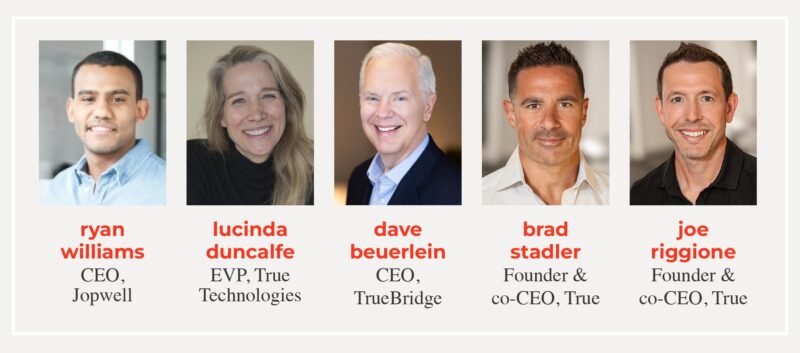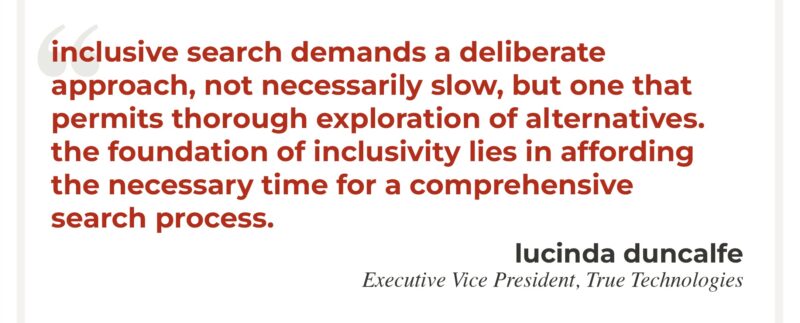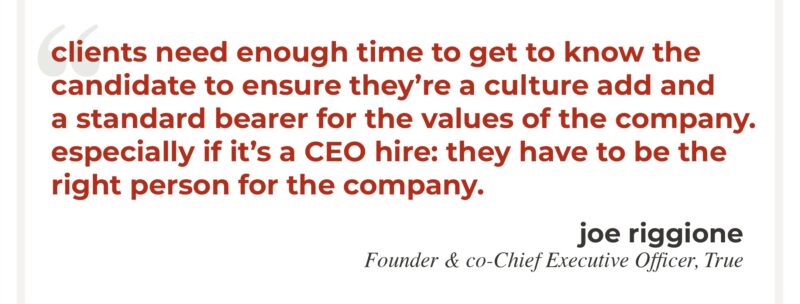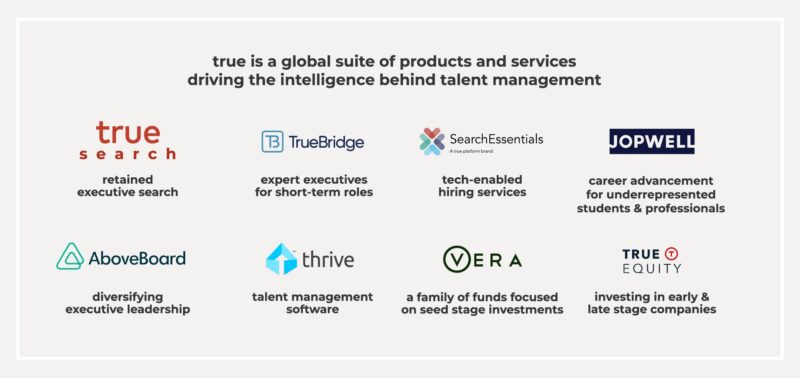Businesses want results fast, and talent acquisition is no exception. When it comes to making critical hires, however, one size does not fit all. A swift ‘time to close’ is not always the right answer.
The best recruitment decisions are made when you understand the full context of your talent needs and set realistic time expectations tailored to reach those goals.
Our CEOs from the True platform, Ryan Williams, Lucinda Duncalfe, David Beuerlein, Brad Stadler and Joe Riggione, share insights on the optimal speed to solve your talent challenges.


For fractional and interim executive recruiting, the pace is always lightning fast. “Speed is more important for TrueBridge than for traditional executive search because clients come to us to solve an urgent business need,” explains CEO David Beuerlein.
Because these business problems typically must be solved in the next six to 12 months, the “time to close” on executives is very short. For example, it took TrueBridge only 48 hours to present their three most recent clients with a slate of qualified candidates, and eight days to have their interim or fractional executive in the seat.
“In 90% of the cases, clients are asking for speed,” Dave says. “By the time they reach out to us there is something on fire.”
Often they engage TrueBridge while simultaneously launching a full-time search. Quickly bringing on an interim leader can provide coverage, allowing for a more measured approach to the full-time search.
For fractional and interim, TrueBridge encourages clients to shorten the interview process they’d typically run for a full-time hire.
The reason TrueBridge can fill client roles immediately is because the TrueBridge team has already done the “slow” work of interviewing and vetting their TrueBridge Talent Network executives, who boast an average of 25 years experience. TrueBridge also can move fast because of their data. They use True’s talent software Thrive TRM to deploy sophisticated tags and filters that allow them to quickly search by skills and experience.


You’ve committed to diversifying your applicant funnel and set short and long term DEI goals. Ryan Williams, CEO and co-founder of Jopwell, says it’s important to know: making speed the number one priority in the hiring process will hinder your ability to consider individuals with transferable skills and hire diverse candidates.

People in a hurry to hire are also more likely to look for candidates with cookie cutter backgrounds from certain schools or employers. Unless a company is extraordinarily diverse and inclusive already, all these tactics retain the status quo and will not improve the diversity of leadership or teams.
Ryan and the Jopwell customer success team instead advise clients to allow time to assess potential candidates for specific skills, attributes and coachability. And, of course, they recommend partnering with a service like Jopwell or AboveBoard that puts companies’ opportunities in front of a pipeline of qualified underrepresented candidates.
“It’s not that we threw our hands up in the air and said speed and diversity can’t coexist,” Ryan says. “It’s just that speed as the single most important factor for filling a requisition is almost always at odds with trying to create an inclusive and representative set of candidates.”

If TrueBridge’s interim world is fast-paced, and Jopwell and AboveBoard are DEI talent platforms that encourage you to slow down—True’s newest business unit, SearchEssentials, and marquee executive search service, True Search, are places where a more measured approach is warranted.
SearchEssentials clients customize their executive search experience using True platform data, technology and recruiters in a “skinny search” process aligned to their budget and talent needs. It’s typically an eight to 12 week process: faster than traditional executive search, but slower than interim and fractional.
EVP True Technologies Lucinda Duncalfe says SearchEssentials can move at pace because they lean on their technology to find candidates and run all their services in parallel. They ensure a diverse slate of candidates by promising that more than half the candidate pool will be underrepresented executives.

“Executive search should have momentum and pace, but it shouldn’t be about speed,” said True co-CEO Brad Stadler.
True Search global executive search clients can expect their search teams to introduce them to the person they’ll eventually hire an average of 26 days into the search (based on True Q3 data.)
Search teams move expeditiously for the clients and executives, but they are well aware that leadership decisions should not be rushed.

That’s because the cost of a mis-hire at the executive level is huge, with many downstream implications. Joe goes on, “the wrong hire can set the wrong strategies. They might hire the wrong people or make poor business decisions, or even poor personal decisions that could have grave impact.”
There are also potential career implications for executives moving too fast to choose their next role.

—
Want to get in touch? hello@trueplatform.com
